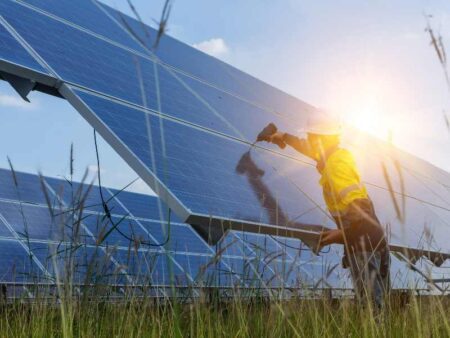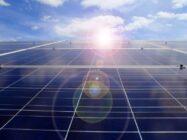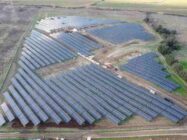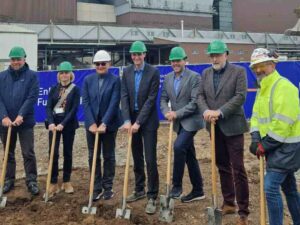
In 2021, the Solar Energy Industries Association (SEIA) announced an ambitious target of increasing solar energy production to 30% of the total energy used in the US by 2030. In 2022 only about 4.7% of the total energy in the US came from solar. So reaching that goal will require adding about 48GW of solar capacity each year, writes Will White of Fluke. But that’s just part of the challenge.
Adding more solar generation capacity means adding more workers. A lot more workers. SEIA estimates that about a million solar workers will be needed to scale, maintain, and operate the clean energy infrastructure required to meet climate goals within that same timeframe. That is nearly a 278% increase from the 263,883 solar workers reported in 2022. Since the solar energy workforce grew by only 3.5% from 2021 to 2022, the challenge is obvious.
The Interstate Renewable Energy Council’s 2022 National Solar Jobs Census reported that 44% of solar industry employers find it “very difficult” to find qualified applicants. Addressing that deficiency will require effort across the value chain to educate, train, and equip workers with the skills and knowledge needed to succeed as solar professionals.
Have you read?
DOE to commit $24m for clean energy workforce training
Business leaders call for more to be done to implement green skills programmes
Like many a long journey, it starts with a methodical step-by-step approach.
Tapping into a rich potential resource of existing skills
As demand for more clean energy workers heats up, the number of jobs in the oil and gas industry is declining. While there has been some recovery in 2022, employment in these industries is down from pre-pandemic levels. Some of that decline is due to layoffs, and some is due to workers leaving the industry to explore opportunities in renewable energy. In a 2021 survey of oil and gas professionals, 56% said they would be interested in pursuing opportunities in the renewables sector, compared to 38.8% who indicated that interest in 2020.
That’s good news because these workers have the skills and energy industry knowledge that will be crucial to quickly building a highly skilled workforce in solar and other renewable energy jobs. It is important to reach out to these energy workers to let them know about the professional opportunities available to them in the solar sector and the training resources available to help them transition into solar energy careers.
Growing industry and government support
Effective training is critical to ensuring the quality and efficiency of new solar power solutions. The U.S. Department of Energy Solar Energy Technologies Office offers a rich set of resources to bring more people into the solar energy workforce. It is also funding workforce training programs to equip solar workers with the skills and expertise to help ensure solar systems are reliable and safe.
To reinforce that support, in July 2023, SEIA gained approval from the American National Standards Institute to develop 11 new national solar and energy storage standards. Included in that group are standards governing training for solar installation, operations and maintenance, and health and safety. These SEIA standards are a critical step toward establishing consistent quality in solar workforce training programs and providing reliable guidance for evaluating potential hires’ skills.
Making training accessible across the board
Expanding the solar workforce quickly will require training to be easily accessible to those transitioning from other industries as well as those just starting out. The training needs to be available both virtually and in person so that workers looking to change careers can take at least some courses without quitting their day jobs. The training must also be accessible nationwide and affordable for all economic levels.
The North American Board of Certified Energy Practitioners (NABCEP) has already taken giant strides in this direction with a broad group of board certifications and associate credentials for photovoltaic and solar heating system installers, technical salespeople, and other renewable energy professionals. Its certifications and credentials are developed with input from hundreds of subject matter experts in the renewable energy industry and are based on demanding standards to meet real-world needs.
NABCEP-approved courses range from basic fundamental concepts for those new to the solar energy field to advanced-level courses for board-certified professionals who want to further develop their knowledge and skills.
Recognizing that apprenticeships are a valuable tool for rapidly expanding a skilled solar workforce, SEIA is also developing resources to help employers implement registered apprenticeship programs. The trend toward building registered apprenticeships is being further fuelled by tax incentives added by the passage of the Inflation Reduction Act which includes requirements for registered apprenticeships for solar projects above 1MW.
Equipping the workforce with the tools they need to succeed
Once solar arrays are installed, it is imperative that they are monitored and maintained to deliver maximum efficiency and safety. According to research from KWh Analytics, solar assets are broadly underperforming by an average of 8%.
Some of the underperformance comes from inverter failure, and some from solar module health issues. So it is essential that solar technicians are able to measure and mediate performance inadequacies to ensure the solar assets meet clean energy targets. New purpose-built multifunction tools and testers, such as the Fluke SMFT-1000, help technicians optimise the performance of clean energy production sites and effectively manage energy intermittency.
These tools, equipped with integrated software, help solar workers quickly and accurately analyse system performance and identify and resolve issues. Ultimately, this means maximizing performance and uptime and minimizing time spent diagnosing and fixing issues. And that will help further stretch the workforce to meet the needs of this rapidly accelerating industry.
About the author

Will White is the Solar Application Specialist at multinational electric tools manufacturer Fluke, where he leads workforce training programs, including Fluke’s NABCEP-Approved course(s), and tool design and development to support and accelerate the growth of the solar workforce for the clean energy future. Will also serves as a contract instructor at Solar Energy International where he teaches online, in-person, and hands-on classes in solar and energy storage. A 20+ year veteran of the renewable energy industry and a NABCEP Certified PV Installation Professional since 2006– starting as a PV module installer, and also working in sales, design, and project management – Will has ample experience in wind power, solar thermal, energy storage, and PV systems.
Originally published on renewableenergyworld.com








